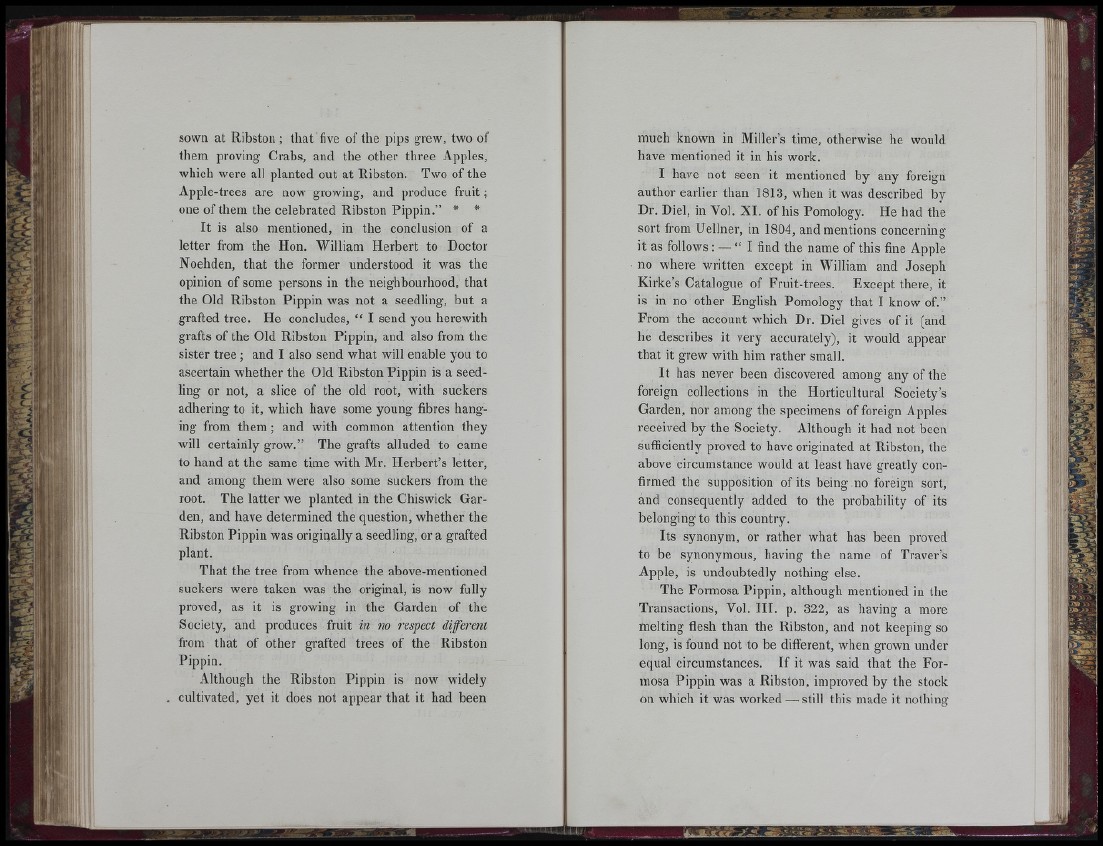
sown at Ribston; that five of the pips grew, two of
them proving Crabs, and the other three Apples,
which were all planted out at Ribston. Two of the
Apple-trees are now growing, and produce fruit;
one of them the celebrated Ribston Pippin.” * *
It is also mentioned, in the conclusion of a
letter from the Hon. William Herbert to Doctor
Noehden, that the former understood it was the
opinion of some persons in the neighbourhood, that
the Old Ribston Pippin was not a seedling, but a
grafted tree. He concludes, “ I send you herewith
grafts of the Old Ribston Pippin, and also from the
sister tree; and I also send what will enable you to
ascertain whether the Old Ribston Pippin is a seedling
or not, a slice of the old root, with suckers
adhering to it, which have some young fibres hanging
from them; and with common attention they
will certainly grow.” The grafts alluded to came
to hand at the same time with Mr. Herbert’s letter,
and among them were also some suckers from the
root. The latter we planted in the Chiswick Garden,
and have determined the question, whether the
Ribston Pippin was originally a seedling, or a grafted
plant.
That the tree from whence the above-mentioned
suckers were taken was the original, is now fully
proved, as it is growing in the Garden of the
Society, and produces fruit in no respect different
from that of other grafted trees of the Ribston
Pippin.
Although the Ribston Pippin is now widely
. cultivated, yet it does not appear that it had been
much known in Miller’s time, otherwise he would
have mentioned it in his work.
I have not seen it mentioned by any foreign
author earlier than 1813, when it was described by
Dr. Diel, in Vol. XI. of his Pomology. He had the
sort from Uellner, in 1804, and mentions concerning
it as follows : — “ I find the name of this fine Apple
no where written except in William and Joseph
Kirke’s Catalogue of Fruit-trees. Except there, it
is in no other English Pomology that I know of.”
From the account which Dr. Diel gives of it (and
he describes it very accurately), it would appear
that it grew with him rather small.
It has never been discovered among any of the
foreign collections in the Horticultural Society’s
Garden, nor among the specimens of foreign Apples
received by the Society. Although it had not been
sufficiently proved to have originated at Ribston, the
above circumstance would at least have greatly confirmed
the supposition of its being no foreign sort,
and consequently added to the probability of its
belonging to this country.
Its synonym, or rather what has been proved
to be synonymous, having the name of Traver’s
Apple, is undoubtedly nothing else.
The Formosa Pippin, although mentioned in the
Transactions, Vol. III. p. 322, as having a more
melting flesh than the Ribston, and not keeping so
long, is found not to be different, when grown under
equal circumstances. If it was said that the Formosa
Pippin was a Ribston, improved by the stock
on which it was worked still this made it nothing